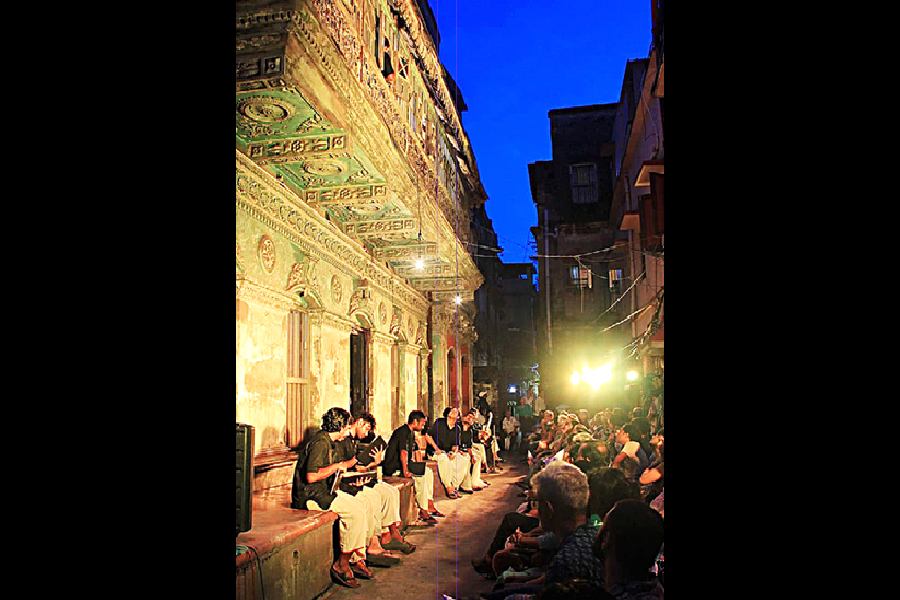A 94-year-old house tucked in a corner of Jorasanko, in north Calcutta, hosted an informal theatrical performance on Saturday evening.
The intricate façade served as the backdrop and the roak (a bench-like structure) outside replaced the conventional stage.
The performance — based on stories strung together in such a way that the house became a part of the design and direction — marked the launch of a campaign that aims to use theatre as a tool for heritage conservation.
Tandonbari, the house on Baranashi Ghosh Street, around 30m from the Tagores’ home Thakurbari, hosted the first in what the organisers have planned as a series of six performances in as many properties in Calcutta.
Around 100 tickets, each priced Rs 350, were sold online for the show. The organisers plan to share a portion of the earnings from the sale of tickets with the homeowners, hoping they would use it to maintain the properties.
Saturday’s performance, which lasted a little over an hour, drew from the works of (poet-playwright) Sadat Hasan Manto, (poet, satirist and scriptwriter) Sharad Joshi and Rabindranath Tagore’s Streer Patra (A Wife’s Letter).
“I selected stories befitting this house and designed and directed them like a new play. Basically, all the pieces put together, they raise a question. The performance questions the conventional idea of progress,” said Anubha Fatehpuria, programme director in Padatik Theatre, an experimental theatre group in its 50th year.
“The old buildings are being dwarfed by new constructions, fancy highrises and condominiums. How important is this heritage, a built-form language that we are losing because we are getting so tempted by big condominiums,” said Fatehpuria, an actor and a practising architect.
She was impressed by the “mixed architecture” of the house. “There is a little bit of European influence. There is a little bit of Mughal influence. That makes it very interesting,” she said.
A campaign note prepared by the organisers describes the façade as a “traffic stopper, comprising intricate designs”.
“The beams have been neatly carved over, enhancing a seamlessness of design. The semi-circular pediment enhances the character of the façade. The structure has been built with a 24-inch wall of brick and mortar, to keep the home cool during summer and warm during winter,” the note said.
The seeds of the campaign, titled “Heritage X Theatre”, were sown in a walk across bylanes of north Calcutta by a south Calcutta resident.
“My job is to walk the streets of north Calcutta, taking pictures of façades. This is one lane where I got lost. I was very happy to take pictures and go home. But when I was editing the pictures, the grandeur of the house struck me. It was a complete theatre,” said Mudar Patherya, a communications consultant and social worker.
Patherya approached Padatik.
“Because it is a bylane off a bylane off a bylane, there is virtually no external sound. The place has excellent acoustics,” said Patherya, who lives on Sarat Chatterjee Avenue, across Rabindra Sarobar, in south Calcutta.
No microphone was used during the performance on Saturday. The resonation off the walls amplified the sound. The performance started at 5pm to make the most of the natural light before, during and after sunset. Artificial lights were also used.
A third-generation co-owner of the house, Rakesh Tandon, was “overwhelmed” as he watched the performance. His grandfather, Shyam Lal Khattri, a cloth merchant, built the house in 1929.
“The foundation of the house is very robust. We have not had to touch the exterior of the house till date,” said Tandon, who is in the electronics business.
The organisers said the campaign is a tribute to all such house-owners who are painstakingly keeping the houses going and not giving in to the temptation of real estate.
“This is not just an effort to find six properties and do six plays. This is basically a call that we are putting out to the artiste community. That all these spaces are available for you to come and perform in the future so that this give-and-take continues between the heritage house-owners and artistes. We can support each other,” said Fatehpuria.
The use of space impressed many in the audience. Author-editor Anjum Katyal was one of them. “There are a couple of aspects to the whole experience. One is the location. One rediscovers and relooks at these old heritage properties with a fresh eye. You are looking because a new context has been created. Otherwise, in this tiny little gully tucked away from everywhere, most people would pass it by without even noticing,” she said.
“They also used the architecture very interestingly. The fact that we are allowed to overhear supposedly private conversations. They used the space quite cleverly to demarcate and show the difference between the two ways of living, the private and the public,” she said.
